The Importance Of Negotiation And A Business Environment
VerifiedAdded on 2020/12/18
|12
|3948
|266
AI Summary
Contribute Materials
Your contribution can guide someone’s learning journey. Share your
documents today.
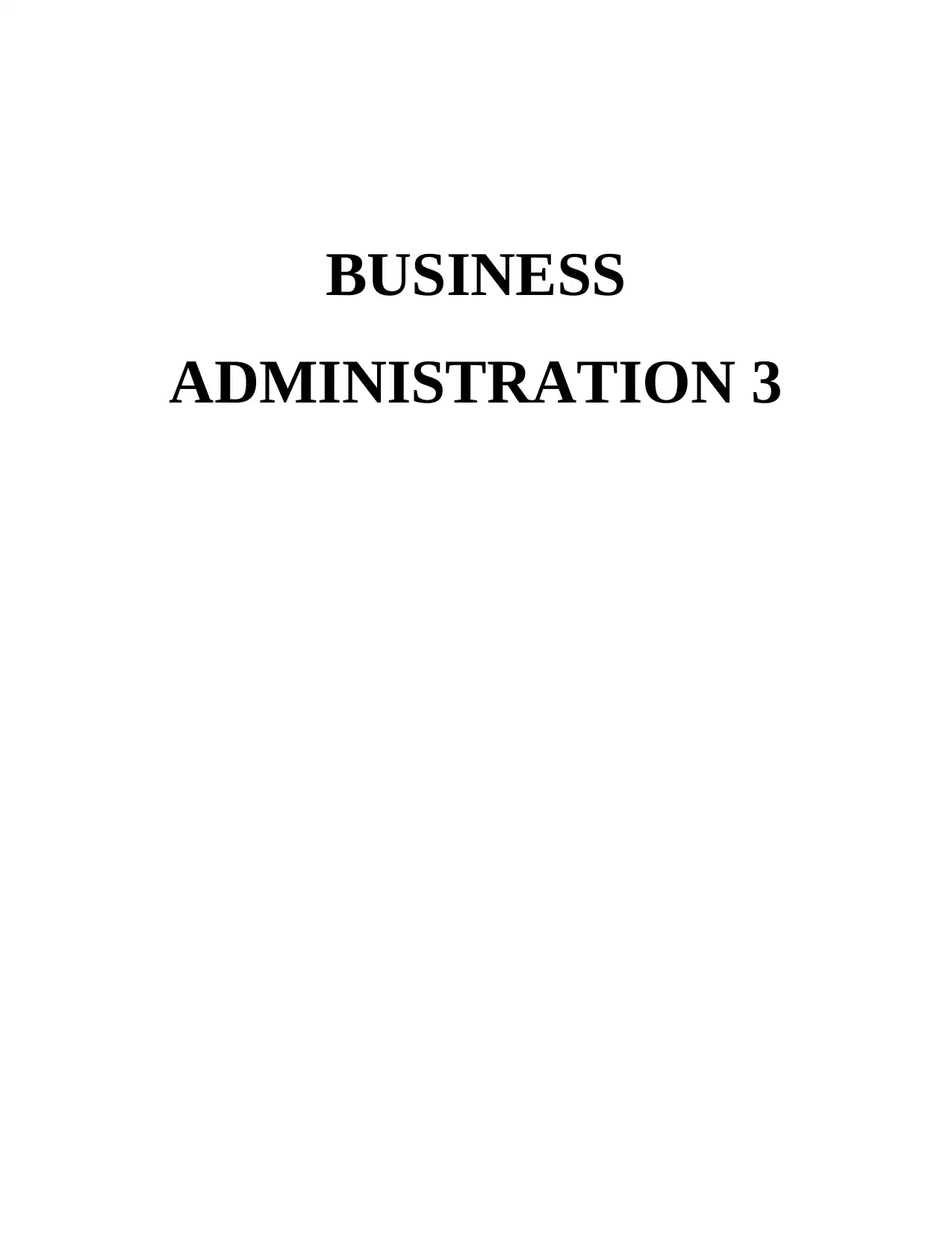
BUSINESS
ADMINISTRATION 3
ADMINISTRATION 3
Secure Best Marks with AI Grader
Need help grading? Try our AI Grader for instant feedback on your assignments.
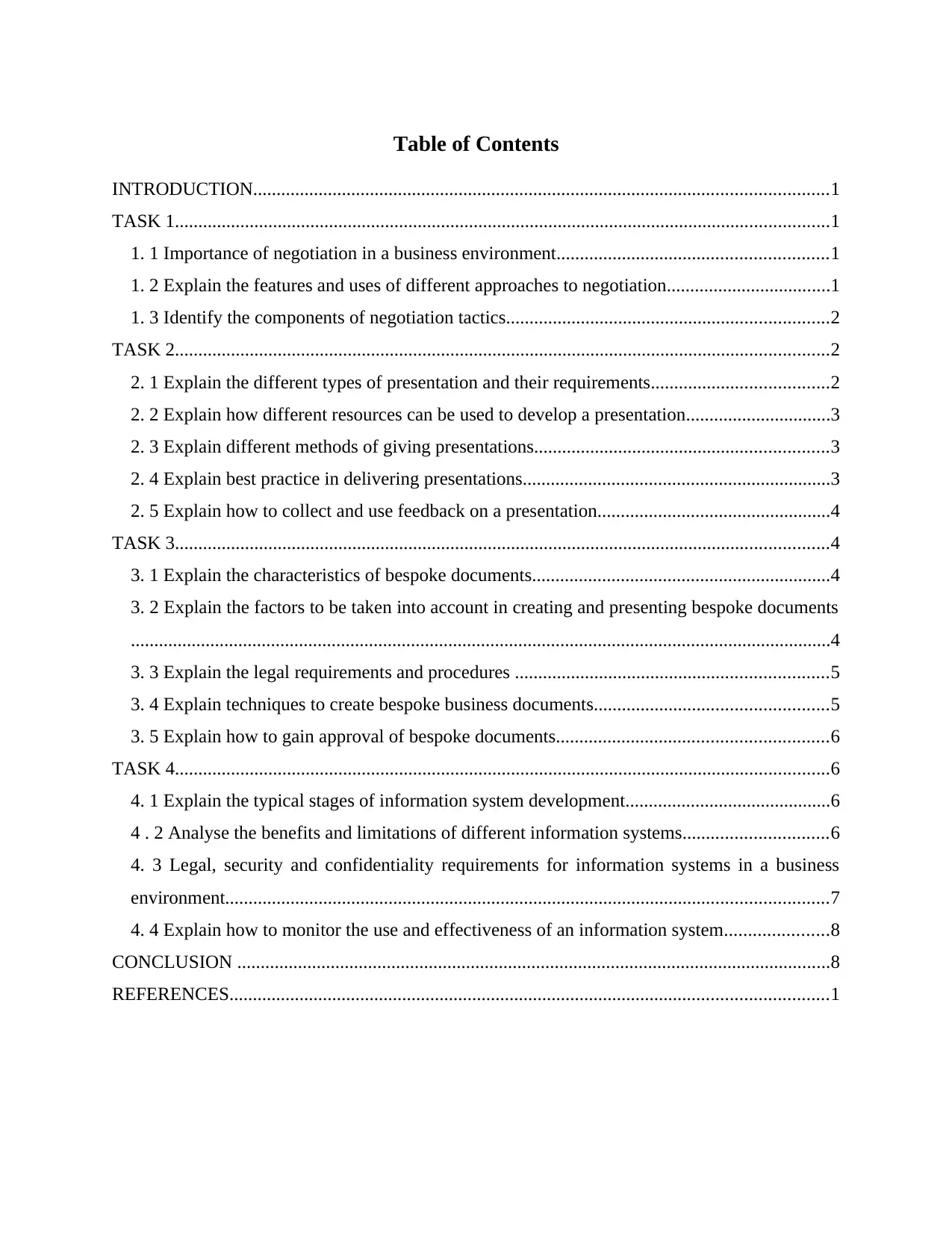
Table of Contents
INTRODUCTION...........................................................................................................................1
TASK 1............................................................................................................................................1
1. 1 Importance of negotiation in a business environment..........................................................1
1. 2 Explain the features and uses of different approaches to negotiation...................................1
1. 3 Identify the components of negotiation tactics.....................................................................2
TASK 2............................................................................................................................................2
2. 1 Explain the different types of presentation and their requirements......................................2
2. 2 Explain how different resources can be used to develop a presentation...............................3
2. 3 Explain different methods of giving presentations...............................................................3
2. 4 Explain best practice in delivering presentations..................................................................3
2. 5 Explain how to collect and use feedback on a presentation..................................................4
TASK 3............................................................................................................................................4
3. 1 Explain the characteristics of bespoke documents................................................................4
3. 2 Explain the factors to be taken into account in creating and presenting bespoke documents
......................................................................................................................................................4
3. 3 Explain the legal requirements and procedures ...................................................................5
3. 4 Explain techniques to create bespoke business documents..................................................5
3. 5 Explain how to gain approval of bespoke documents..........................................................6
TASK 4............................................................................................................................................6
4. 1 Explain the typical stages of information system development............................................6
4 . 2 Analyse the benefits and limitations of different information systems...............................6
4. 3 Legal, security and confidentiality requirements for information systems in a business
environment.................................................................................................................................7
4. 4 Explain how to monitor the use and effectiveness of an information system......................8
CONCLUSION ...............................................................................................................................8
REFERENCES................................................................................................................................1
INTRODUCTION...........................................................................................................................1
TASK 1............................................................................................................................................1
1. 1 Importance of negotiation in a business environment..........................................................1
1. 2 Explain the features and uses of different approaches to negotiation...................................1
1. 3 Identify the components of negotiation tactics.....................................................................2
TASK 2............................................................................................................................................2
2. 1 Explain the different types of presentation and their requirements......................................2
2. 2 Explain how different resources can be used to develop a presentation...............................3
2. 3 Explain different methods of giving presentations...............................................................3
2. 4 Explain best practice in delivering presentations..................................................................3
2. 5 Explain how to collect and use feedback on a presentation..................................................4
TASK 3............................................................................................................................................4
3. 1 Explain the characteristics of bespoke documents................................................................4
3. 2 Explain the factors to be taken into account in creating and presenting bespoke documents
......................................................................................................................................................4
3. 3 Explain the legal requirements and procedures ...................................................................5
3. 4 Explain techniques to create bespoke business documents..................................................5
3. 5 Explain how to gain approval of bespoke documents..........................................................6
TASK 4............................................................................................................................................6
4. 1 Explain the typical stages of information system development............................................6
4 . 2 Analyse the benefits and limitations of different information systems...............................6
4. 3 Legal, security and confidentiality requirements for information systems in a business
environment.................................................................................................................................7
4. 4 Explain how to monitor the use and effectiveness of an information system......................8
CONCLUSION ...............................................................................................................................8
REFERENCES................................................................................................................................1
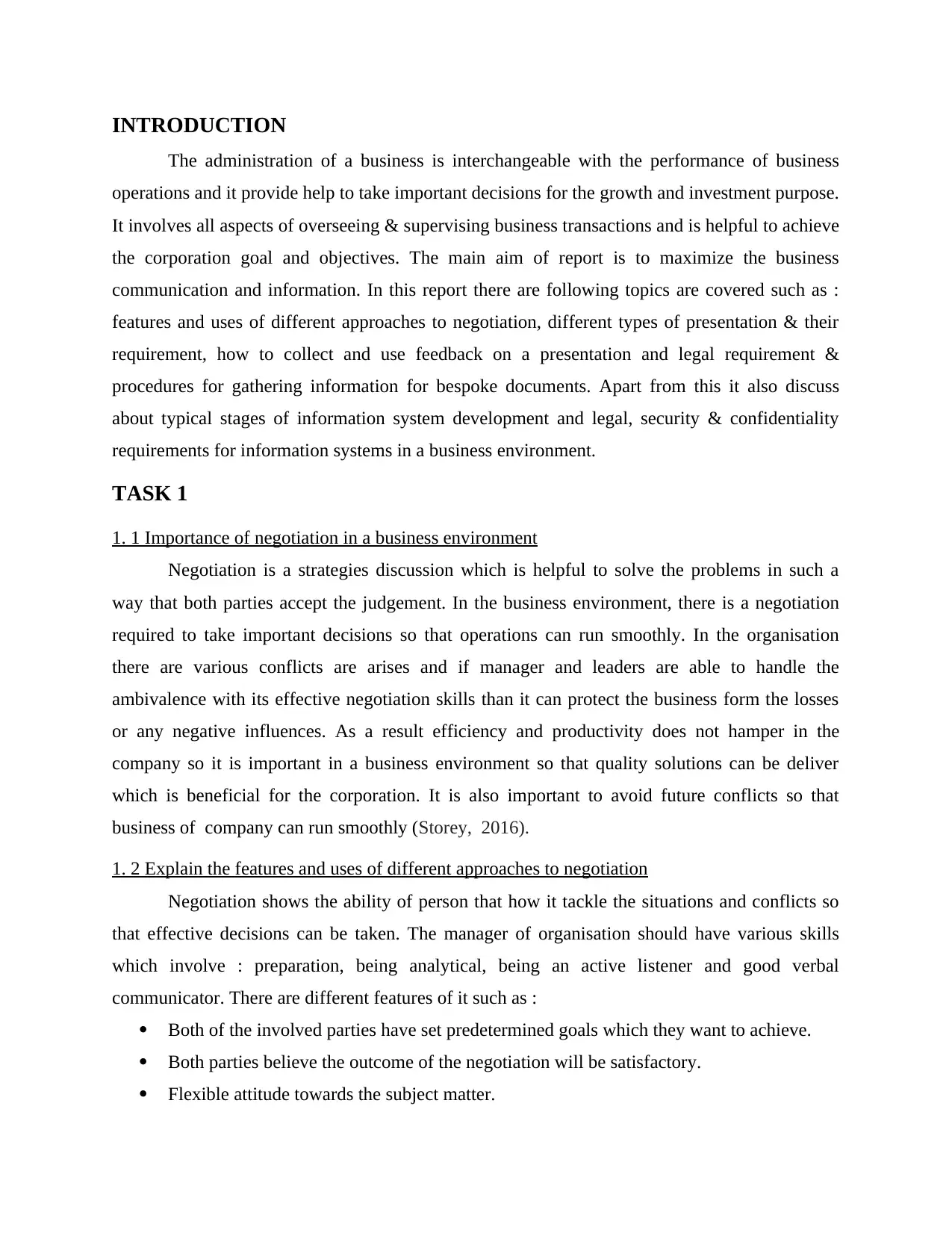
INTRODUCTION
The administration of a business is interchangeable with the performance of business
operations and it provide help to take important decisions for the growth and investment purpose.
It involves all aspects of overseeing & supervising business transactions and is helpful to achieve
the corporation goal and objectives. The main aim of report is to maximize the business
communication and information. In this report there are following topics are covered such as :
features and uses of different approaches to negotiation, different types of presentation & their
requirement, how to collect and use feedback on a presentation and legal requirement &
procedures for gathering information for bespoke documents. Apart from this it also discuss
about typical stages of information system development and legal, security & confidentiality
requirements for information systems in a business environment.
TASK 1
1. 1 Importance of negotiation in a business environment
Negotiation is a strategies discussion which is helpful to solve the problems in such a
way that both parties accept the judgement. In the business environment, there is a negotiation
required to take important decisions so that operations can run smoothly. In the organisation
there are various conflicts are arises and if manager and leaders are able to handle the
ambivalence with its effective negotiation skills than it can protect the business form the losses
or any negative influences. As a result efficiency and productivity does not hamper in the
company so it is important in a business environment so that quality solutions can be deliver
which is beneficial for the corporation. It is also important to avoid future conflicts so that
business of company can run smoothly (Storey, 2016).
1. 2 Explain the features and uses of different approaches to negotiation
Negotiation shows the ability of person that how it tackle the situations and conflicts so
that effective decisions can be taken. The manager of organisation should have various skills
which involve : preparation, being analytical, being an active listener and good verbal
communicator. There are different features of it such as :
Both of the involved parties have set predetermined goals which they want to achieve.
Both parties believe the outcome of the negotiation will be satisfactory.
Flexible attitude towards the subject matter.
The administration of a business is interchangeable with the performance of business
operations and it provide help to take important decisions for the growth and investment purpose.
It involves all aspects of overseeing & supervising business transactions and is helpful to achieve
the corporation goal and objectives. The main aim of report is to maximize the business
communication and information. In this report there are following topics are covered such as :
features and uses of different approaches to negotiation, different types of presentation & their
requirement, how to collect and use feedback on a presentation and legal requirement &
procedures for gathering information for bespoke documents. Apart from this it also discuss
about typical stages of information system development and legal, security & confidentiality
requirements for information systems in a business environment.
TASK 1
1. 1 Importance of negotiation in a business environment
Negotiation is a strategies discussion which is helpful to solve the problems in such a
way that both parties accept the judgement. In the business environment, there is a negotiation
required to take important decisions so that operations can run smoothly. In the organisation
there are various conflicts are arises and if manager and leaders are able to handle the
ambivalence with its effective negotiation skills than it can protect the business form the losses
or any negative influences. As a result efficiency and productivity does not hamper in the
company so it is important in a business environment so that quality solutions can be deliver
which is beneficial for the corporation. It is also important to avoid future conflicts so that
business of company can run smoothly (Storey, 2016).
1. 2 Explain the features and uses of different approaches to negotiation
Negotiation shows the ability of person that how it tackle the situations and conflicts so
that effective decisions can be taken. The manager of organisation should have various skills
which involve : preparation, being analytical, being an active listener and good verbal
communicator. There are different features of it such as :
Both of the involved parties have set predetermined goals which they want to achieve.
Both parties believe the outcome of the negotiation will be satisfactory.
Flexible attitude towards the subject matter.
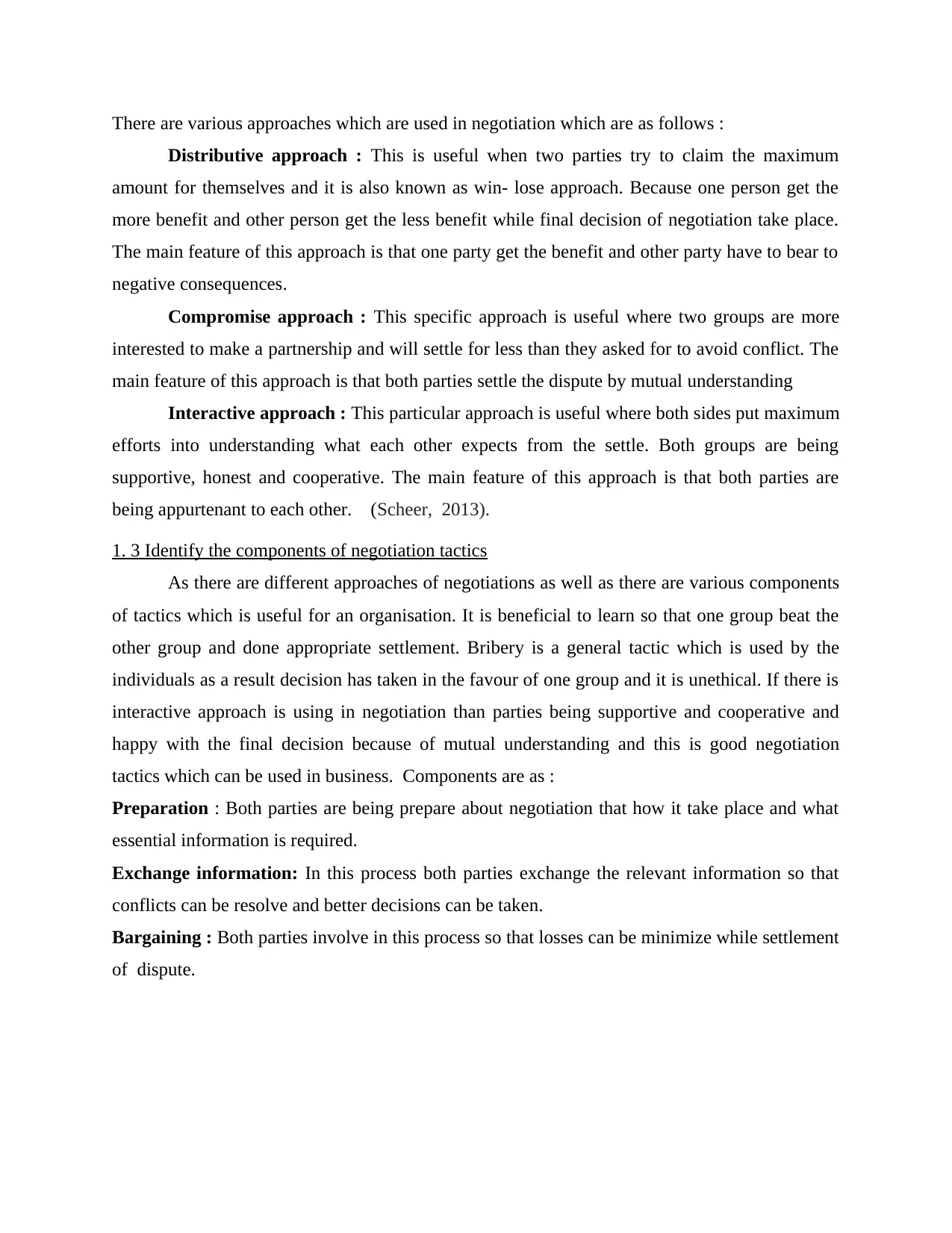
There are various approaches which are used in negotiation which are as follows :
Distributive approach : This is useful when two parties try to claim the maximum
amount for themselves and it is also known as win- lose approach. Because one person get the
more benefit and other person get the less benefit while final decision of negotiation take place.
The main feature of this approach is that one party get the benefit and other party have to bear to
negative consequences.
Compromise approach : This specific approach is useful where two groups are more
interested to make a partnership and will settle for less than they asked for to avoid conflict. The
main feature of this approach is that both parties settle the dispute by mutual understanding
Interactive approach : This particular approach is useful where both sides put maximum
efforts into understanding what each other expects from the settle. Both groups are being
supportive, honest and cooperative. The main feature of this approach is that both parties are
being appurtenant to each other. (Scheer, 2013).
1. 3 Identify the components of negotiation tactics
As there are different approaches of negotiations as well as there are various components
of tactics which is useful for an organisation. It is beneficial to learn so that one group beat the
other group and done appropriate settlement. Bribery is a general tactic which is used by the
individuals as a result decision has taken in the favour of one group and it is unethical. If there is
interactive approach is using in negotiation than parties being supportive and cooperative and
happy with the final decision because of mutual understanding and this is good negotiation
tactics which can be used in business. Components are as :
Preparation : Both parties are being prepare about negotiation that how it take place and what
essential information is required.
Exchange information: In this process both parties exchange the relevant information so that
conflicts can be resolve and better decisions can be taken.
Bargaining : Both parties involve in this process so that losses can be minimize while settlement
of dispute.
Distributive approach : This is useful when two parties try to claim the maximum
amount for themselves and it is also known as win- lose approach. Because one person get the
more benefit and other person get the less benefit while final decision of negotiation take place.
The main feature of this approach is that one party get the benefit and other party have to bear to
negative consequences.
Compromise approach : This specific approach is useful where two groups are more
interested to make a partnership and will settle for less than they asked for to avoid conflict. The
main feature of this approach is that both parties settle the dispute by mutual understanding
Interactive approach : This particular approach is useful where both sides put maximum
efforts into understanding what each other expects from the settle. Both groups are being
supportive, honest and cooperative. The main feature of this approach is that both parties are
being appurtenant to each other. (Scheer, 2013).
1. 3 Identify the components of negotiation tactics
As there are different approaches of negotiations as well as there are various components
of tactics which is useful for an organisation. It is beneficial to learn so that one group beat the
other group and done appropriate settlement. Bribery is a general tactic which is used by the
individuals as a result decision has taken in the favour of one group and it is unethical. If there is
interactive approach is using in negotiation than parties being supportive and cooperative and
happy with the final decision because of mutual understanding and this is good negotiation
tactics which can be used in business. Components are as :
Preparation : Both parties are being prepare about negotiation that how it take place and what
essential information is required.
Exchange information: In this process both parties exchange the relevant information so that
conflicts can be resolve and better decisions can be taken.
Bargaining : Both parties involve in this process so that losses can be minimize while settlement
of dispute.
Secure Best Marks with AI Grader
Need help grading? Try our AI Grader for instant feedback on your assignments.
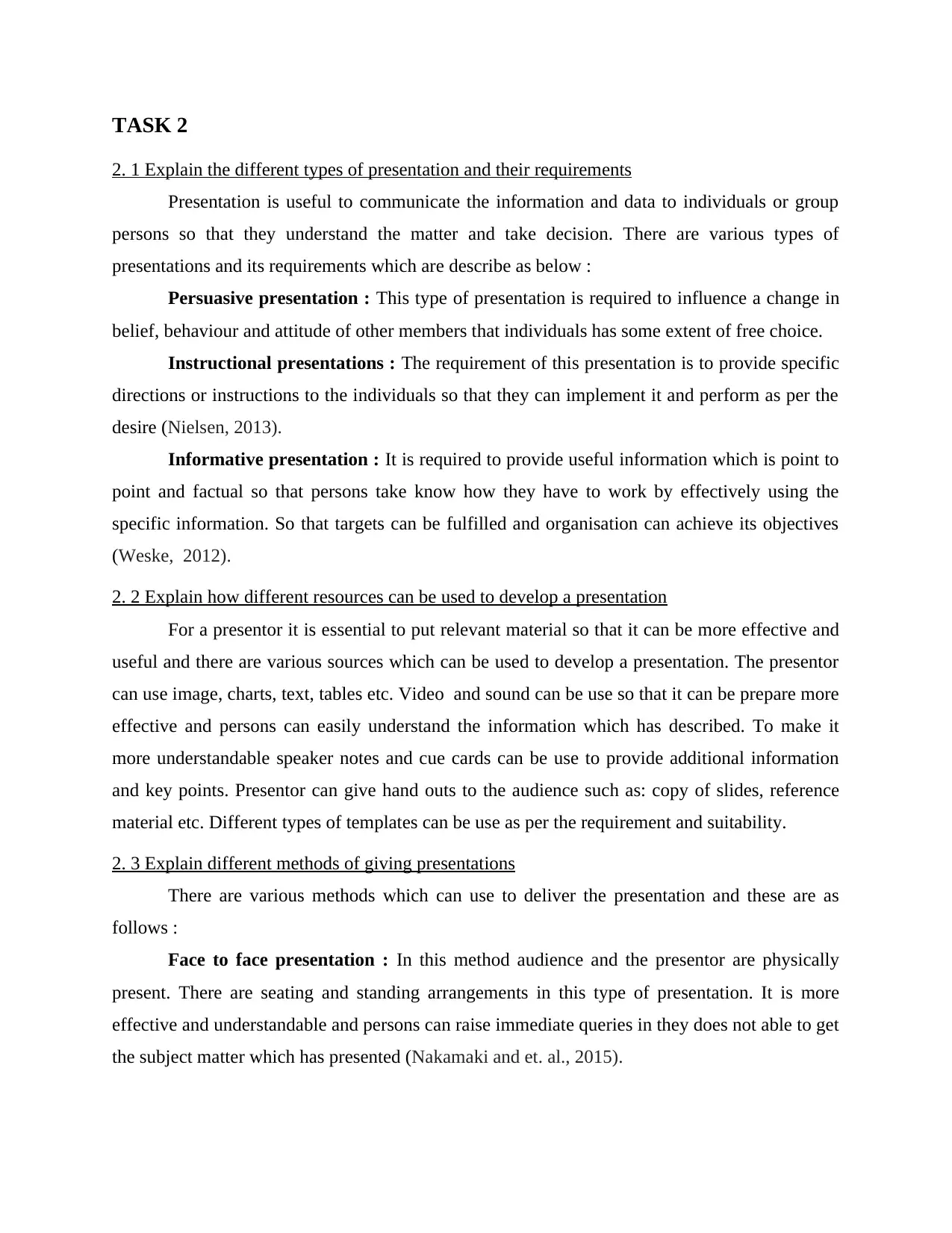
TASK 2
2. 1 Explain the different types of presentation and their requirements
Presentation is useful to communicate the information and data to individuals or group
persons so that they understand the matter and take decision. There are various types of
presentations and its requirements which are describe as below :
Persuasive presentation : This type of presentation is required to influence a change in
belief, behaviour and attitude of other members that individuals has some extent of free choice.
Instructional presentations : The requirement of this presentation is to provide specific
directions or instructions to the individuals so that they can implement it and perform as per the
desire (Nielsen, 2013).
Informative presentation : It is required to provide useful information which is point to
point and factual so that persons take know how they have to work by effectively using the
specific information. So that targets can be fulfilled and organisation can achieve its objectives
(Weske, 2012).
2. 2 Explain how different resources can be used to develop a presentation
For a presentor it is essential to put relevant material so that it can be more effective and
useful and there are various sources which can be used to develop a presentation. The presentor
can use image, charts, text, tables etc. Video and sound can be use so that it can be prepare more
effective and persons can easily understand the information which has described. To make it
more understandable speaker notes and cue cards can be use to provide additional information
and key points. Presentor can give hand outs to the audience such as: copy of slides, reference
material etc. Different types of templates can be use as per the requirement and suitability.
2. 3 Explain different methods of giving presentations
There are various methods which can use to deliver the presentation and these are as
follows :
Face to face presentation : In this method audience and the presentor are physically
present. There are seating and standing arrangements in this type of presentation. It is more
effective and understandable and persons can raise immediate queries in they does not able to get
the subject matter which has presented (Nakamaki and et. al., 2015).
2. 1 Explain the different types of presentation and their requirements
Presentation is useful to communicate the information and data to individuals or group
persons so that they understand the matter and take decision. There are various types of
presentations and its requirements which are describe as below :
Persuasive presentation : This type of presentation is required to influence a change in
belief, behaviour and attitude of other members that individuals has some extent of free choice.
Instructional presentations : The requirement of this presentation is to provide specific
directions or instructions to the individuals so that they can implement it and perform as per the
desire (Nielsen, 2013).
Informative presentation : It is required to provide useful information which is point to
point and factual so that persons take know how they have to work by effectively using the
specific information. So that targets can be fulfilled and organisation can achieve its objectives
(Weske, 2012).
2. 2 Explain how different resources can be used to develop a presentation
For a presentor it is essential to put relevant material so that it can be more effective and
useful and there are various sources which can be used to develop a presentation. The presentor
can use image, charts, text, tables etc. Video and sound can be use so that it can be prepare more
effective and persons can easily understand the information which has described. To make it
more understandable speaker notes and cue cards can be use to provide additional information
and key points. Presentor can give hand outs to the audience such as: copy of slides, reference
material etc. Different types of templates can be use as per the requirement and suitability.
2. 3 Explain different methods of giving presentations
There are various methods which can use to deliver the presentation and these are as
follows :
Face to face presentation : In this method audience and the presentor are physically
present. There are seating and standing arrangements in this type of presentation. It is more
effective and understandable and persons can raise immediate queries in they does not able to get
the subject matter which has presented (Nakamaki and et. al., 2015).
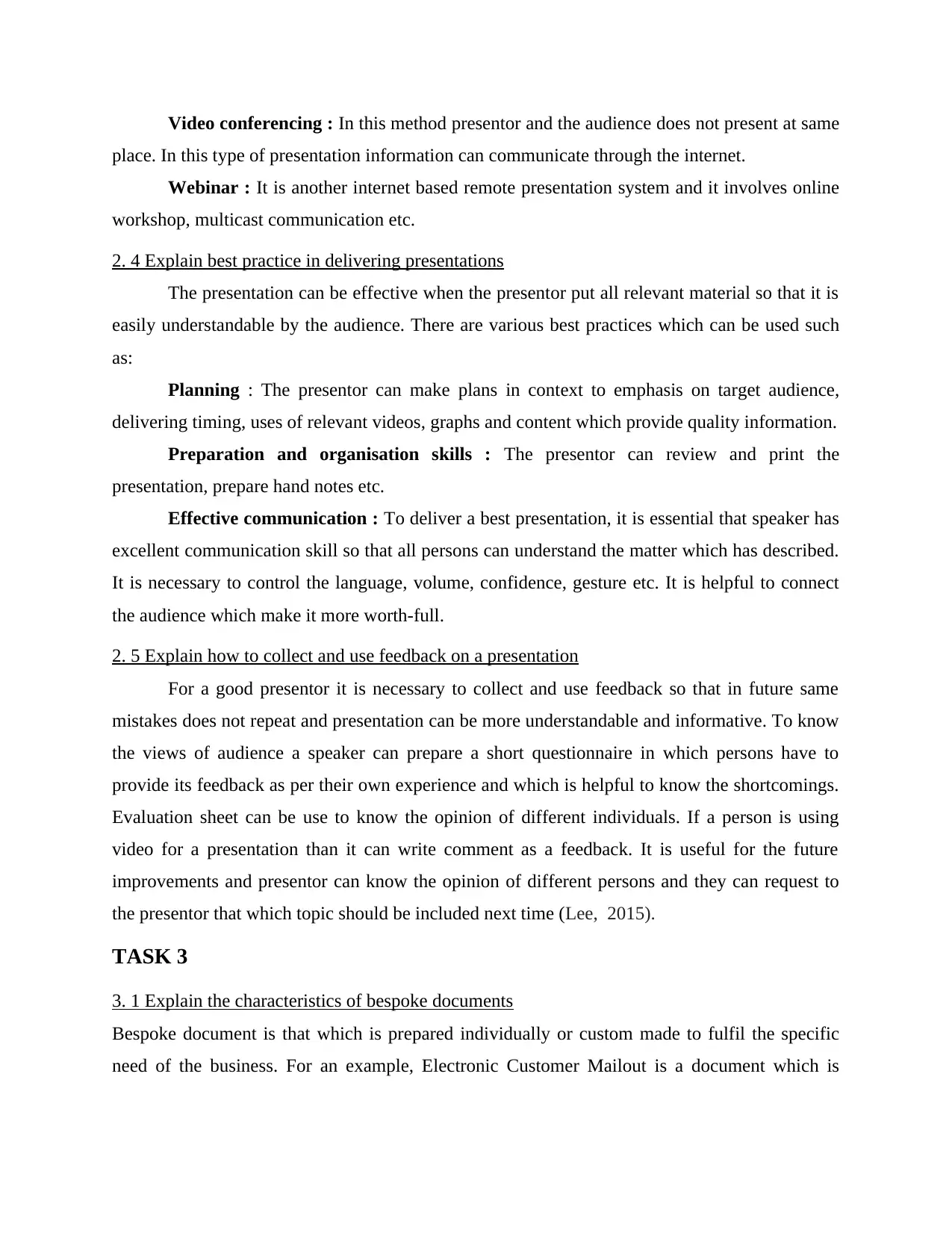
Video conferencing : In this method presentor and the audience does not present at same
place. In this type of presentation information can communicate through the internet.
Webinar : It is another internet based remote presentation system and it involves online
workshop, multicast communication etc.
2. 4 Explain best practice in delivering presentations
The presentation can be effective when the presentor put all relevant material so that it is
easily understandable by the audience. There are various best practices which can be used such
as:
Planning : The presentor can make plans in context to emphasis on target audience,
delivering timing, uses of relevant videos, graphs and content which provide quality information.
Preparation and organisation skills : The presentor can review and print the
presentation, prepare hand notes etc.
Effective communication : To deliver a best presentation, it is essential that speaker has
excellent communication skill so that all persons can understand the matter which has described.
It is necessary to control the language, volume, confidence, gesture etc. It is helpful to connect
the audience which make it more worth-full.
2. 5 Explain how to collect and use feedback on a presentation
For a good presentor it is necessary to collect and use feedback so that in future same
mistakes does not repeat and presentation can be more understandable and informative. To know
the views of audience a speaker can prepare a short questionnaire in which persons have to
provide its feedback as per their own experience and which is helpful to know the shortcomings.
Evaluation sheet can be use to know the opinion of different individuals. If a person is using
video for a presentation than it can write comment as a feedback. It is useful for the future
improvements and presentor can know the opinion of different persons and they can request to
the presentor that which topic should be included next time (Lee, 2015).
TASK 3
3. 1 Explain the characteristics of bespoke documents
Bespoke document is that which is prepared individually or custom made to fulfil the specific
need of the business. For an example, Electronic Customer Mailout is a document which is
place. In this type of presentation information can communicate through the internet.
Webinar : It is another internet based remote presentation system and it involves online
workshop, multicast communication etc.
2. 4 Explain best practice in delivering presentations
The presentation can be effective when the presentor put all relevant material so that it is
easily understandable by the audience. There are various best practices which can be used such
as:
Planning : The presentor can make plans in context to emphasis on target audience,
delivering timing, uses of relevant videos, graphs and content which provide quality information.
Preparation and organisation skills : The presentor can review and print the
presentation, prepare hand notes etc.
Effective communication : To deliver a best presentation, it is essential that speaker has
excellent communication skill so that all persons can understand the matter which has described.
It is necessary to control the language, volume, confidence, gesture etc. It is helpful to connect
the audience which make it more worth-full.
2. 5 Explain how to collect and use feedback on a presentation
For a good presentor it is necessary to collect and use feedback so that in future same
mistakes does not repeat and presentation can be more understandable and informative. To know
the views of audience a speaker can prepare a short questionnaire in which persons have to
provide its feedback as per their own experience and which is helpful to know the shortcomings.
Evaluation sheet can be use to know the opinion of different individuals. If a person is using
video for a presentation than it can write comment as a feedback. It is useful for the future
improvements and presentor can know the opinion of different persons and they can request to
the presentor that which topic should be included next time (Lee, 2015).
TASK 3
3. 1 Explain the characteristics of bespoke documents
Bespoke document is that which is prepared individually or custom made to fulfil the specific
need of the business. For an example, Electronic Customer Mailout is a document which is
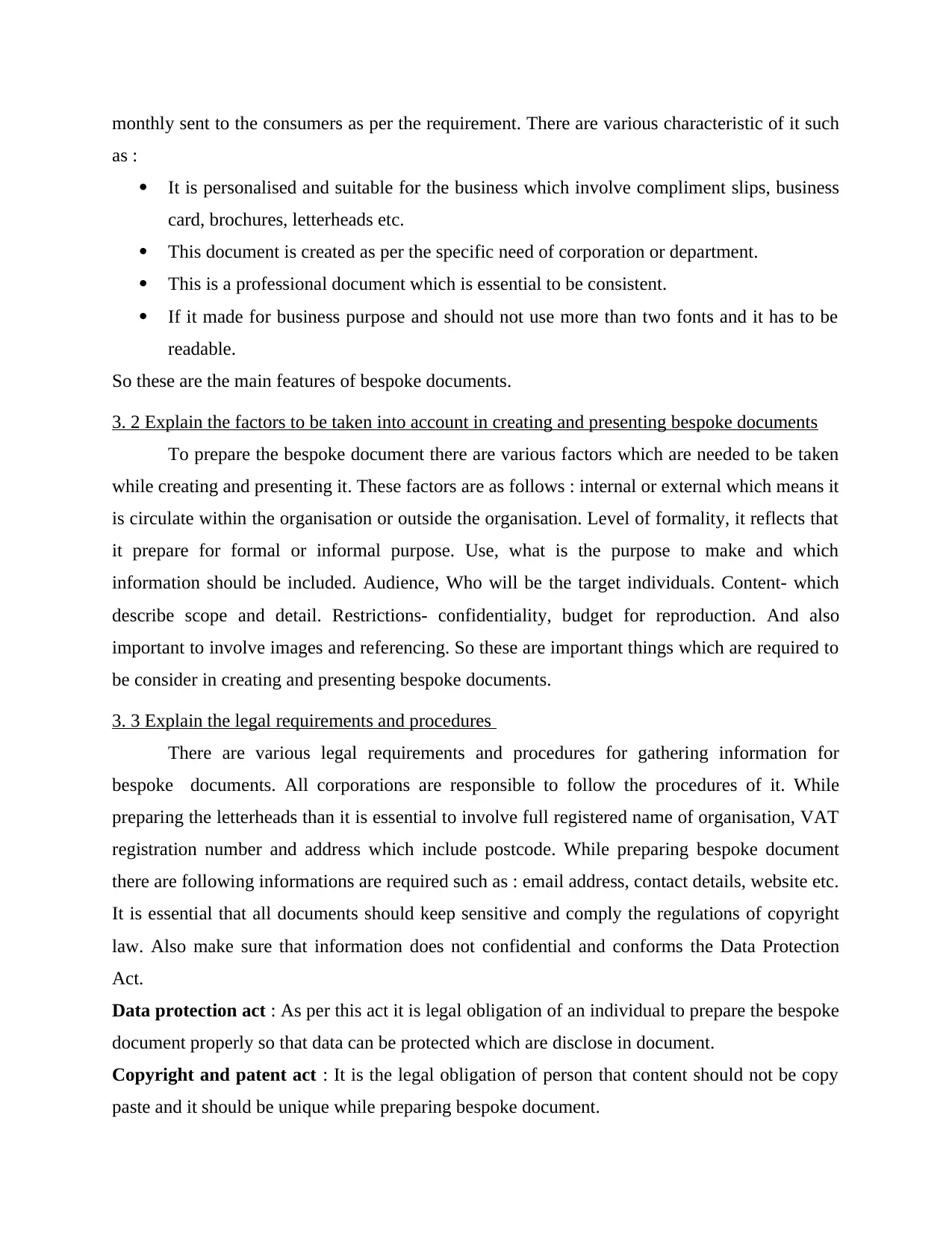
monthly sent to the consumers as per the requirement. There are various characteristic of it such
as :
It is personalised and suitable for the business which involve compliment slips, business
card, brochures, letterheads etc.
This document is created as per the specific need of corporation or department.
This is a professional document which is essential to be consistent.
If it made for business purpose and should not use more than two fonts and it has to be
readable.
So these are the main features of bespoke documents.
3. 2 Explain the factors to be taken into account in creating and presenting bespoke documents
To prepare the bespoke document there are various factors which are needed to be taken
while creating and presenting it. These factors are as follows : internal or external which means it
is circulate within the organisation or outside the organisation. Level of formality, it reflects that
it prepare for formal or informal purpose. Use, what is the purpose to make and which
information should be included. Audience, Who will be the target individuals. Content- which
describe scope and detail. Restrictions- confidentiality, budget for reproduction. And also
important to involve images and referencing. So these are important things which are required to
be consider in creating and presenting bespoke documents.
3. 3 Explain the legal requirements and procedures
There are various legal requirements and procedures for gathering information for
bespoke documents. All corporations are responsible to follow the procedures of it. While
preparing the letterheads than it is essential to involve full registered name of organisation, VAT
registration number and address which include postcode. While preparing bespoke document
there are following informations are required such as : email address, contact details, website etc.
It is essential that all documents should keep sensitive and comply the regulations of copyright
law. Also make sure that information does not confidential and conforms the Data Protection
Act.
Data protection act : As per this act it is legal obligation of an individual to prepare the bespoke
document properly so that data can be protected which are disclose in document.
Copyright and patent act : It is the legal obligation of person that content should not be copy
paste and it should be unique while preparing bespoke document.
as :
It is personalised and suitable for the business which involve compliment slips, business
card, brochures, letterheads etc.
This document is created as per the specific need of corporation or department.
This is a professional document which is essential to be consistent.
If it made for business purpose and should not use more than two fonts and it has to be
readable.
So these are the main features of bespoke documents.
3. 2 Explain the factors to be taken into account in creating and presenting bespoke documents
To prepare the bespoke document there are various factors which are needed to be taken
while creating and presenting it. These factors are as follows : internal or external which means it
is circulate within the organisation or outside the organisation. Level of formality, it reflects that
it prepare for formal or informal purpose. Use, what is the purpose to make and which
information should be included. Audience, Who will be the target individuals. Content- which
describe scope and detail. Restrictions- confidentiality, budget for reproduction. And also
important to involve images and referencing. So these are important things which are required to
be consider in creating and presenting bespoke documents.
3. 3 Explain the legal requirements and procedures
There are various legal requirements and procedures for gathering information for
bespoke documents. All corporations are responsible to follow the procedures of it. While
preparing the letterheads than it is essential to involve full registered name of organisation, VAT
registration number and address which include postcode. While preparing bespoke document
there are following informations are required such as : email address, contact details, website etc.
It is essential that all documents should keep sensitive and comply the regulations of copyright
law. Also make sure that information does not confidential and conforms the Data Protection
Act.
Data protection act : As per this act it is legal obligation of an individual to prepare the bespoke
document properly so that data can be protected which are disclose in document.
Copyright and patent act : It is the legal obligation of person that content should not be copy
paste and it should be unique while preparing bespoke document.
Paraphrase This Document
Need a fresh take? Get an instant paraphrase of this document with our AI Paraphraser
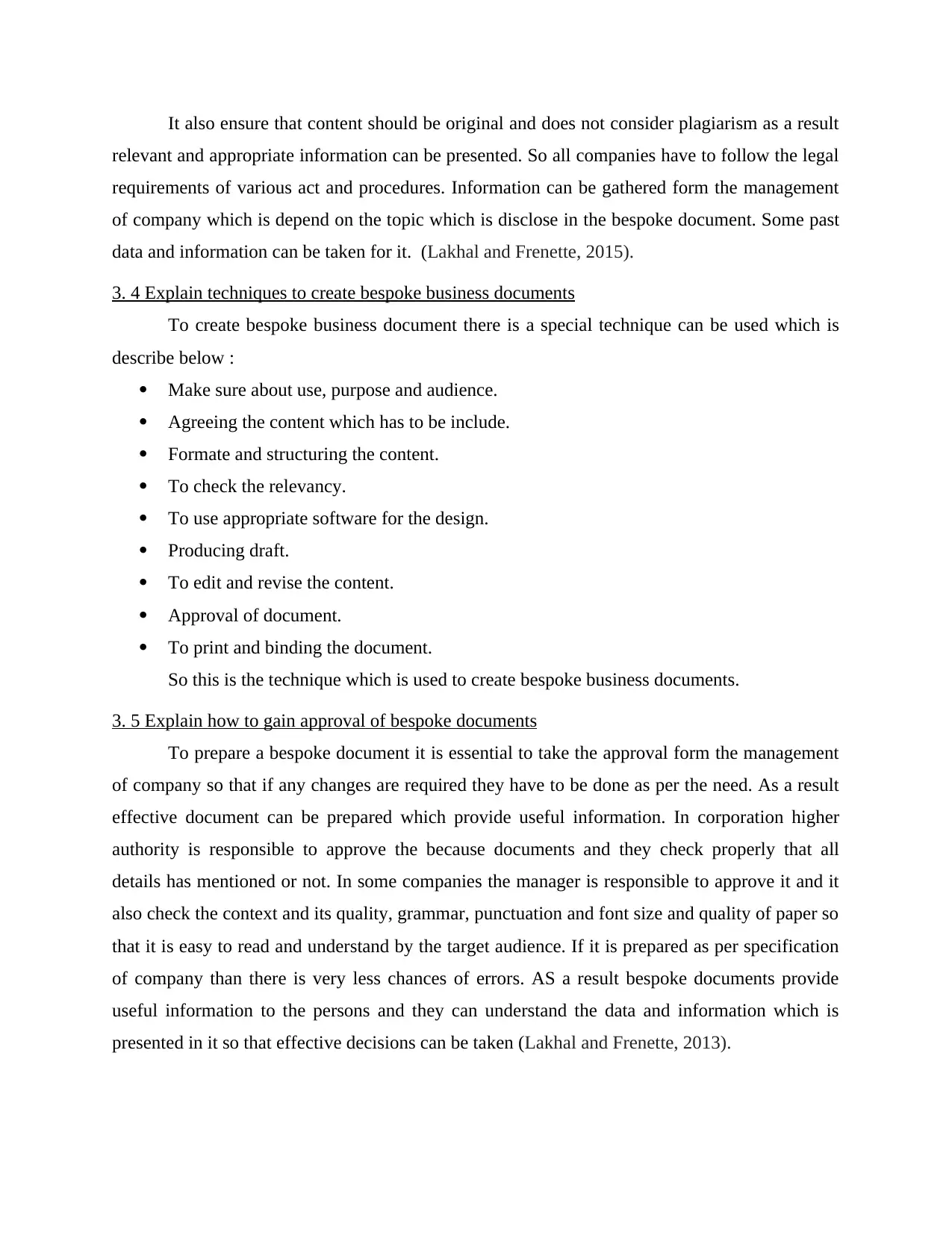
It also ensure that content should be original and does not consider plagiarism as a result
relevant and appropriate information can be presented. So all companies have to follow the legal
requirements of various act and procedures. Information can be gathered form the management
of company which is depend on the topic which is disclose in the bespoke document. Some past
data and information can be taken for it. (Lakhal and Frenette, 2015).
3. 4 Explain techniques to create bespoke business documents
To create bespoke business document there is a special technique can be used which is
describe below :
Make sure about use, purpose and audience.
Agreeing the content which has to be include.
Formate and structuring the content.
To check the relevancy.
To use appropriate software for the design.
Producing draft.
To edit and revise the content.
Approval of document.
To print and binding the document.
So this is the technique which is used to create bespoke business documents.
3. 5 Explain how to gain approval of bespoke documents
To prepare a bespoke document it is essential to take the approval form the management
of company so that if any changes are required they have to be done as per the need. As a result
effective document can be prepared which provide useful information. In corporation higher
authority is responsible to approve the because documents and they check properly that all
details has mentioned or not. In some companies the manager is responsible to approve it and it
also check the context and its quality, grammar, punctuation and font size and quality of paper so
that it is easy to read and understand by the target audience. If it is prepared as per specification
of company than there is very less chances of errors. AS a result bespoke documents provide
useful information to the persons and they can understand the data and information which is
presented in it so that effective decisions can be taken (Lakhal and Frenette, 2013).
relevant and appropriate information can be presented. So all companies have to follow the legal
requirements of various act and procedures. Information can be gathered form the management
of company which is depend on the topic which is disclose in the bespoke document. Some past
data and information can be taken for it. (Lakhal and Frenette, 2015).
3. 4 Explain techniques to create bespoke business documents
To create bespoke business document there is a special technique can be used which is
describe below :
Make sure about use, purpose and audience.
Agreeing the content which has to be include.
Formate and structuring the content.
To check the relevancy.
To use appropriate software for the design.
Producing draft.
To edit and revise the content.
Approval of document.
To print and binding the document.
So this is the technique which is used to create bespoke business documents.
3. 5 Explain how to gain approval of bespoke documents
To prepare a bespoke document it is essential to take the approval form the management
of company so that if any changes are required they have to be done as per the need. As a result
effective document can be prepared which provide useful information. In corporation higher
authority is responsible to approve the because documents and they check properly that all
details has mentioned or not. In some companies the manager is responsible to approve it and it
also check the context and its quality, grammar, punctuation and font size and quality of paper so
that it is easy to read and understand by the target audience. If it is prepared as per specification
of company than there is very less chances of errors. AS a result bespoke documents provide
useful information to the persons and they can understand the data and information which is
presented in it so that effective decisions can be taken (Lakhal and Frenette, 2013).
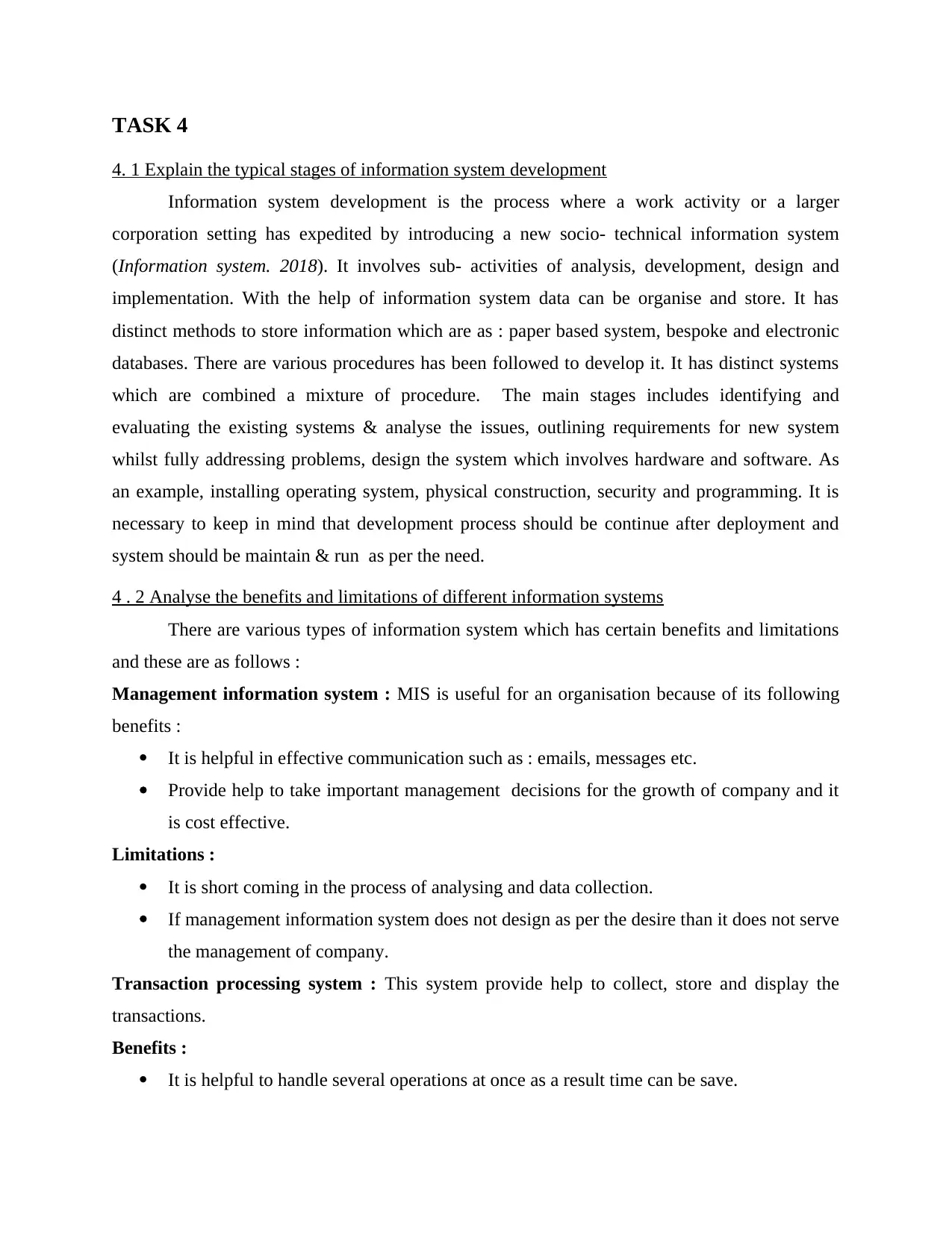
TASK 4
4. 1 Explain the typical stages of information system development
Information system development is the process where a work activity or a larger
corporation setting has expedited by introducing a new socio- technical information system
(Information system. 2018). It involves sub- activities of analysis, development, design and
implementation. With the help of information system data can be organise and store. It has
distinct methods to store information which are as : paper based system, bespoke and electronic
databases. There are various procedures has been followed to develop it. It has distinct systems
which are combined a mixture of procedure. The main stages includes identifying and
evaluating the existing systems & analyse the issues, outlining requirements for new system
whilst fully addressing problems, design the system which involves hardware and software. As
an example, installing operating system, physical construction, security and programming. It is
necessary to keep in mind that development process should be continue after deployment and
system should be maintain & run as per the need.
4 . 2 Analyse the benefits and limitations of different information systems
There are various types of information system which has certain benefits and limitations
and these are as follows :
Management information system : MIS is useful for an organisation because of its following
benefits :
It is helpful in effective communication such as : emails, messages etc.
Provide help to take important management decisions for the growth of company and it
is cost effective.
Limitations :
It is short coming in the process of analysing and data collection.
If management information system does not design as per the desire than it does not serve
the management of company.
Transaction processing system : This system provide help to collect, store and display the
transactions.
Benefits :
It is helpful to handle several operations at once as a result time can be save.
4. 1 Explain the typical stages of information system development
Information system development is the process where a work activity or a larger
corporation setting has expedited by introducing a new socio- technical information system
(Information system. 2018). It involves sub- activities of analysis, development, design and
implementation. With the help of information system data can be organise and store. It has
distinct methods to store information which are as : paper based system, bespoke and electronic
databases. There are various procedures has been followed to develop it. It has distinct systems
which are combined a mixture of procedure. The main stages includes identifying and
evaluating the existing systems & analyse the issues, outlining requirements for new system
whilst fully addressing problems, design the system which involves hardware and software. As
an example, installing operating system, physical construction, security and programming. It is
necessary to keep in mind that development process should be continue after deployment and
system should be maintain & run as per the need.
4 . 2 Analyse the benefits and limitations of different information systems
There are various types of information system which has certain benefits and limitations
and these are as follows :
Management information system : MIS is useful for an organisation because of its following
benefits :
It is helpful in effective communication such as : emails, messages etc.
Provide help to take important management decisions for the growth of company and it
is cost effective.
Limitations :
It is short coming in the process of analysing and data collection.
If management information system does not design as per the desire than it does not serve
the management of company.
Transaction processing system : This system provide help to collect, store and display the
transactions.
Benefits :
It is helpful to handle several operations at once as a result time can be save.
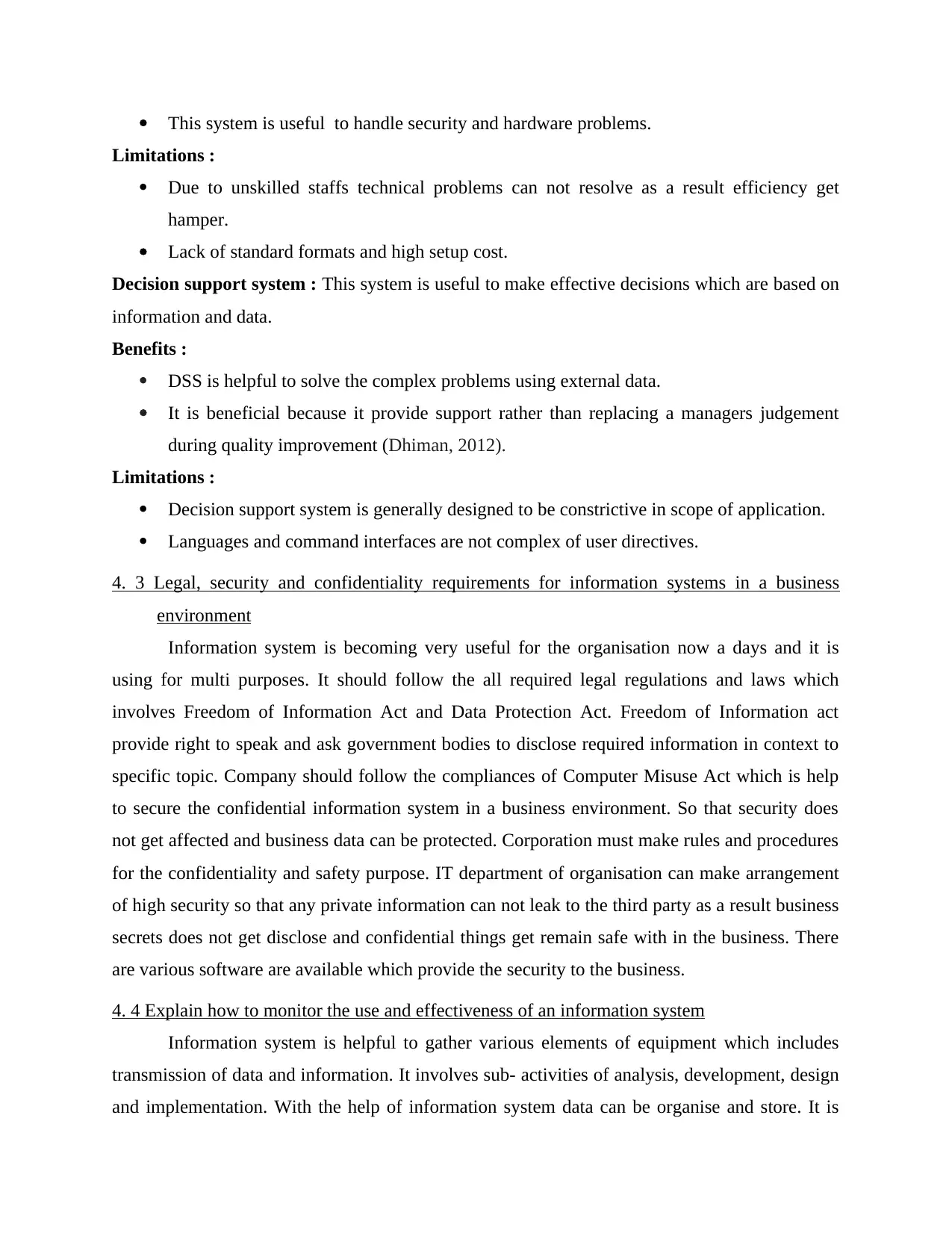
This system is useful to handle security and hardware problems.
Limitations :
Due to unskilled staffs technical problems can not resolve as a result efficiency get
hamper.
Lack of standard formats and high setup cost.
Decision support system : This system is useful to make effective decisions which are based on
information and data.
Benefits :
DSS is helpful to solve the complex problems using external data.
It is beneficial because it provide support rather than replacing a managers judgement
during quality improvement (Dhiman, 2012).
Limitations :
Decision support system is generally designed to be constrictive in scope of application.
Languages and command interfaces are not complex of user directives.
4. 3 Legal, security and confidentiality requirements for information systems in a business
environment
Information system is becoming very useful for the organisation now a days and it is
using for multi purposes. It should follow the all required legal regulations and laws which
involves Freedom of Information Act and Data Protection Act. Freedom of Information act
provide right to speak and ask government bodies to disclose required information in context to
specific topic. Company should follow the compliances of Computer Misuse Act which is help
to secure the confidential information system in a business environment. So that security does
not get affected and business data can be protected. Corporation must make rules and procedures
for the confidentiality and safety purpose. IT department of organisation can make arrangement
of high security so that any private information can not leak to the third party as a result business
secrets does not get disclose and confidential things get remain safe with in the business. There
are various software are available which provide the security to the business.
4. 4 Explain how to monitor the use and effectiveness of an information system
Information system is helpful to gather various elements of equipment which includes
transmission of data and information. It involves sub- activities of analysis, development, design
and implementation. With the help of information system data can be organise and store. It is
Limitations :
Due to unskilled staffs technical problems can not resolve as a result efficiency get
hamper.
Lack of standard formats and high setup cost.
Decision support system : This system is useful to make effective decisions which are based on
information and data.
Benefits :
DSS is helpful to solve the complex problems using external data.
It is beneficial because it provide support rather than replacing a managers judgement
during quality improvement (Dhiman, 2012).
Limitations :
Decision support system is generally designed to be constrictive in scope of application.
Languages and command interfaces are not complex of user directives.
4. 3 Legal, security and confidentiality requirements for information systems in a business
environment
Information system is becoming very useful for the organisation now a days and it is
using for multi purposes. It should follow the all required legal regulations and laws which
involves Freedom of Information Act and Data Protection Act. Freedom of Information act
provide right to speak and ask government bodies to disclose required information in context to
specific topic. Company should follow the compliances of Computer Misuse Act which is help
to secure the confidential information system in a business environment. So that security does
not get affected and business data can be protected. Corporation must make rules and procedures
for the confidentiality and safety purpose. IT department of organisation can make arrangement
of high security so that any private information can not leak to the third party as a result business
secrets does not get disclose and confidential things get remain safe with in the business. There
are various software are available which provide the security to the business.
4. 4 Explain how to monitor the use and effectiveness of an information system
Information system is helpful to gather various elements of equipment which includes
transmission of data and information. It involves sub- activities of analysis, development, design
and implementation. With the help of information system data can be organise and store. It is
Secure Best Marks with AI Grader
Need help grading? Try our AI Grader for instant feedback on your assignments.
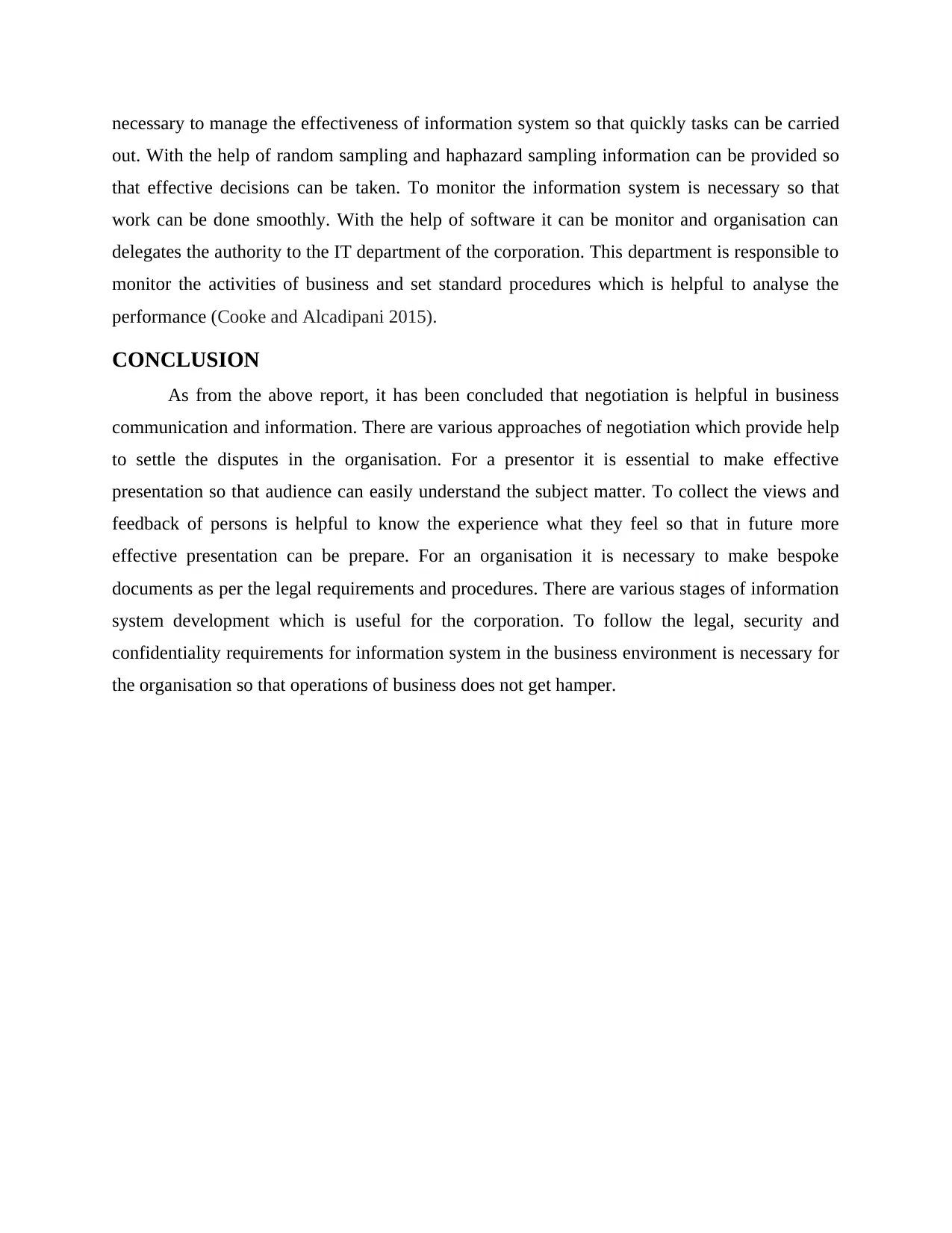
necessary to manage the effectiveness of information system so that quickly tasks can be carried
out. With the help of random sampling and haphazard sampling information can be provided so
that effective decisions can be taken. To monitor the information system is necessary so that
work can be done smoothly. With the help of software it can be monitor and organisation can
delegates the authority to the IT department of the corporation. This department is responsible to
monitor the activities of business and set standard procedures which is helpful to analyse the
performance (Cooke and Alcadipani 2015).
CONCLUSION
As from the above report, it has been concluded that negotiation is helpful in business
communication and information. There are various approaches of negotiation which provide help
to settle the disputes in the organisation. For a presentor it is essential to make effective
presentation so that audience can easily understand the subject matter. To collect the views and
feedback of persons is helpful to know the experience what they feel so that in future more
effective presentation can be prepare. For an organisation it is necessary to make bespoke
documents as per the legal requirements and procedures. There are various stages of information
system development which is useful for the corporation. To follow the legal, security and
confidentiality requirements for information system in the business environment is necessary for
the organisation so that operations of business does not get hamper.
out. With the help of random sampling and haphazard sampling information can be provided so
that effective decisions can be taken. To monitor the information system is necessary so that
work can be done smoothly. With the help of software it can be monitor and organisation can
delegates the authority to the IT department of the corporation. This department is responsible to
monitor the activities of business and set standard procedures which is helpful to analyse the
performance (Cooke and Alcadipani 2015).
CONCLUSION
As from the above report, it has been concluded that negotiation is helpful in business
communication and information. There are various approaches of negotiation which provide help
to settle the disputes in the organisation. For a presentor it is essential to make effective
presentation so that audience can easily understand the subject matter. To collect the views and
feedback of persons is helpful to know the experience what they feel so that in future more
effective presentation can be prepare. For an organisation it is necessary to make bespoke
documents as per the legal requirements and procedures. There are various stages of information
system development which is useful for the corporation. To follow the legal, security and
confidentiality requirements for information system in the business environment is necessary for
the organisation so that operations of business does not get hamper.
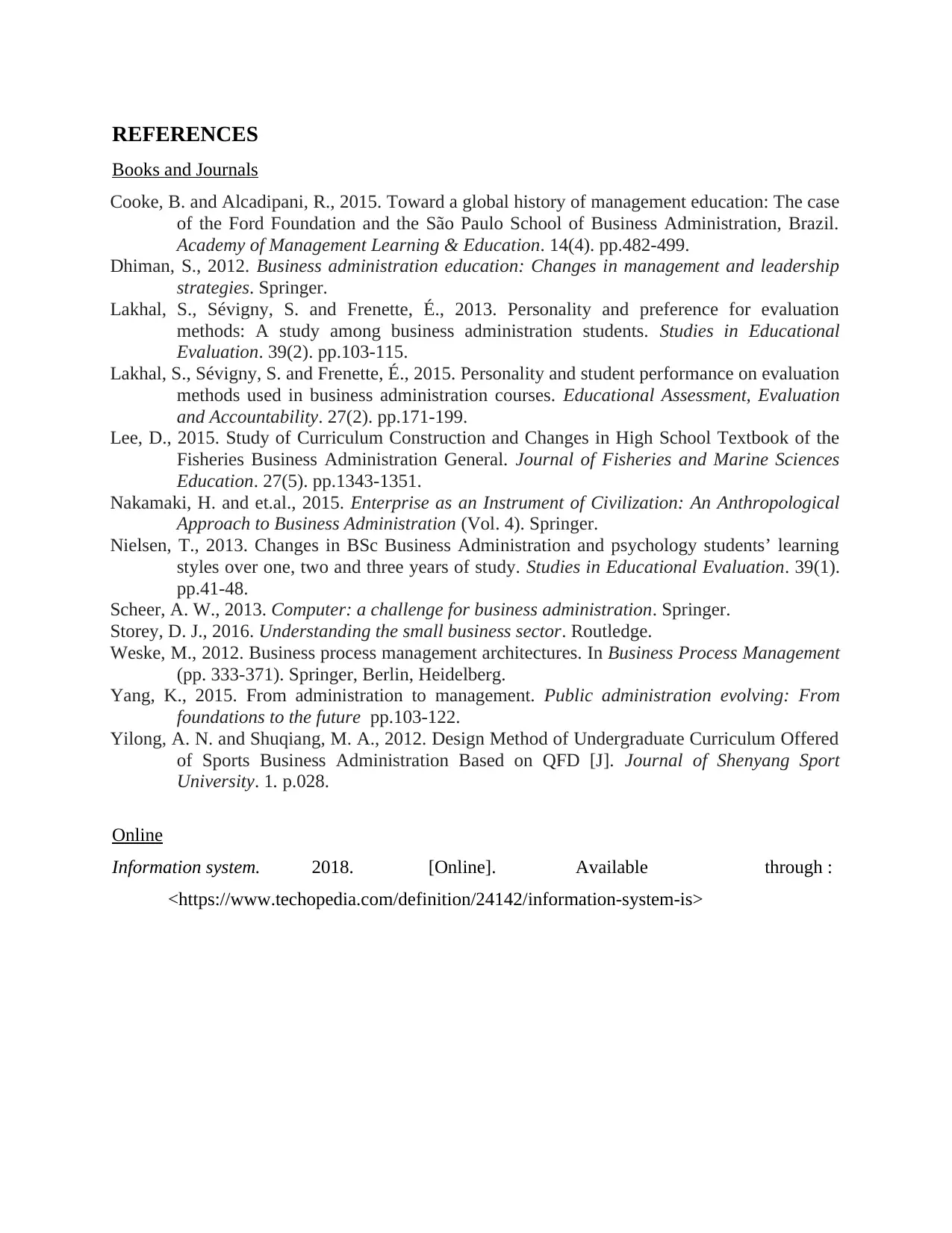
REFERENCES
Books and Journals
Cooke, B. and Alcadipani, R., 2015. Toward a global history of management education: The case
of the Ford Foundation and the São Paulo School of Business Administration, Brazil.
Academy of Management Learning & Education. 14(4). pp.482-499.
Dhiman, S., 2012. Business administration education: Changes in management and leadership
strategies. Springer.
Lakhal, S., Sévigny, S. and Frenette, É., 2013. Personality and preference for evaluation
methods: A study among business administration students. Studies in Educational
Evaluation. 39(2). pp.103-115.
Lakhal, S., Sévigny, S. and Frenette, É., 2015. Personality and student performance on evaluation
methods used in business administration courses. Educational Assessment, Evaluation
and Accountability. 27(2). pp.171-199.
Lee, D., 2015. Study of Curriculum Construction and Changes in High School Textbook of the
Fisheries Business Administration General. Journal of Fisheries and Marine Sciences
Education. 27(5). pp.1343-1351.
Nakamaki, H. and et.al., 2015. Enterprise as an Instrument of Civilization: An Anthropological
Approach to Business Administration (Vol. 4). Springer.
Nielsen, T., 2013. Changes in BSc Business Administration and psychology students’ learning
styles over one, two and three years of study. Studies in Educational Evaluation. 39(1).
pp.41-48.
Scheer, A. W., 2013. Computer: a challenge for business administration. Springer.
Storey, D. J., 2016. Understanding the small business sector. Routledge.
Weske, M., 2012. Business process management architectures. In Business Process Management
(pp. 333-371). Springer, Berlin, Heidelberg.
Yang, K., 2015. From administration to management. Public administration evolving: From
foundations to the future pp.103-122.
Yilong, A. N. and Shuqiang, M. A., 2012. Design Method of Undergraduate Curriculum Offered
of Sports Business Administration Based on QFD [J]. Journal of Shenyang Sport
University. 1. p.028.
Online
Information system. 2018. [Online]. Available through :
<https://www.techopedia.com/definition/24142/information-system-is>
Books and Journals
Cooke, B. and Alcadipani, R., 2015. Toward a global history of management education: The case
of the Ford Foundation and the São Paulo School of Business Administration, Brazil.
Academy of Management Learning & Education. 14(4). pp.482-499.
Dhiman, S., 2012. Business administration education: Changes in management and leadership
strategies. Springer.
Lakhal, S., Sévigny, S. and Frenette, É., 2013. Personality and preference for evaluation
methods: A study among business administration students. Studies in Educational
Evaluation. 39(2). pp.103-115.
Lakhal, S., Sévigny, S. and Frenette, É., 2015. Personality and student performance on evaluation
methods used in business administration courses. Educational Assessment, Evaluation
and Accountability. 27(2). pp.171-199.
Lee, D., 2015. Study of Curriculum Construction and Changes in High School Textbook of the
Fisheries Business Administration General. Journal of Fisheries and Marine Sciences
Education. 27(5). pp.1343-1351.
Nakamaki, H. and et.al., 2015. Enterprise as an Instrument of Civilization: An Anthropological
Approach to Business Administration (Vol. 4). Springer.
Nielsen, T., 2013. Changes in BSc Business Administration and psychology students’ learning
styles over one, two and three years of study. Studies in Educational Evaluation. 39(1).
pp.41-48.
Scheer, A. W., 2013. Computer: a challenge for business administration. Springer.
Storey, D. J., 2016. Understanding the small business sector. Routledge.
Weske, M., 2012. Business process management architectures. In Business Process Management
(pp. 333-371). Springer, Berlin, Heidelberg.
Yang, K., 2015. From administration to management. Public administration evolving: From
foundations to the future pp.103-122.
Yilong, A. N. and Shuqiang, M. A., 2012. Design Method of Undergraduate Curriculum Offered
of Sports Business Administration Based on QFD [J]. Journal of Shenyang Sport
University. 1. p.028.
Online
Information system. 2018. [Online]. Available through :
<https://www.techopedia.com/definition/24142/information-system-is>
1 out of 12
Related Documents
Your All-in-One AI-Powered Toolkit for Academic Success.
+13062052269
info@desklib.com
Available 24*7 on WhatsApp / Email
![[object Object]](/_next/static/media/star-bottom.7253800d.svg)
Unlock your academic potential
© 2024 | Zucol Services PVT LTD | All rights reserved.





